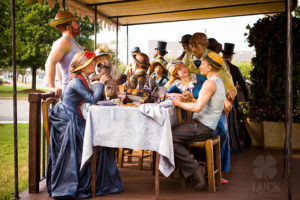I’ve never known quite what to make of Grounds for Sculpture. Is it a legitimate sculpture park? Or is it a gigantic outdoor vanity gallery, where its founder, J. Seward Johnson Jr., an heir to the Johnson & Johnson fortune, can showcase his own work?
After 10 years, the answer seems to be … both. There’s no denying that it’s an important venue for contemporary sculpture. Since it opened in 1992, 545 artists have exhibited here, among them Magdalena Abakanowicz, George Segal, Marisol, Ursula von Rydingsvard, Red Grooms, Tom Otterness, Isaac Witkin, and Mel Kendrick.

J. Seward Johnson’s three-dimensional take on Renoir’s “Luncheon of the Boating Party.”
But Johnson’s quirky imprint and presence are dominant, and it’s hard to avoid the sense of visiting a rich man’s architectural folly.
His painted bronze castings of famous impressionist paintings are among the oddest, kitchiest things in today’s art world —which is saying a lot.
This is not meant to discourage you from going. Go, by all means. Pick a quiet weekday, a time most conducive to it unique, Alice-in-Wonderland experience.
This place is all about small surprises, about following curious little paths that lead into tiny bamboo forests or hedge-enclosed rooms, of mysterious courtyards and ancient-looking walls. It’s about charming, sun-dappled tables nestled in around the willows that edge a quiet lake. It’s about fanciful bronze animals and portentous, Stonehenge-like columns. It’s about lotus ponds and gazebos with watchtowers. It’s about coming around a bend and scratching your head with disbelief as you find yourself in the middle of Renoir’s “The Luncheon of the Boating Party.”
It’s not at all like visiting the 500-acre Storm King Art Center in New York, where the emphasis is on monumental, welded-steel abstractions and the way they play against sky and mountains. Storm King is about modernist purity. Grounds for Sculpture, formerly the New Jersey State Fairgrounds, has only 22 acres. Contemporary sculpture is the focus, rather than classic modernism. It is much more gardenesque in scale and design — the landscaping is at least half the show here — and more eclectic and eccentric in its tastes.
Temporary exhibits are held in three renovated buildings that once belonged to the fairgrounds. Two date from the Twenties and are handsome structures of yellow stucco, brick, and green wood trim, with colorful ceramic tiles arching over their entrances. The other, more utilitarian building was built in the Forties for 4-H-type shows and has been cleverly transformed into an airy, high-tech exhibition hall.
There and in the Domestic Arts Building are where you’ll find the 10th Anniversary Invitational exhibit. One of my favorites among the 20 artists here is Dana Stewart, who sculpts imaginary animals, such as “Boomer,” a prehistoric wolf with a Brontosaurus tail.
John Newman is best known at Grounds for Sculpture for “Skyhook,” a 25-foot-high S-shaped wire-mesh construction, partially filled with stone, that is one of the first pieces you see on setting out. On view here is “Gone Awry”: a cartoonish length of segmented duct. Spewing out of one end is a braided steel cable that spills onto the floor in a tangle, while, out of the other is a pinkish, organic probe of seemingly alien origin.
A rising star here is James Dinerstein, whose “Sky-gatherer” is pigmented pink cement with the soft look of clay. It is a nest of biomorphic flap-like forms that suggest such things as a human ear, a whale’s tail, and a shark’s fin.
Beverly Pepper’s “Hera Triad” and “Demeter Fragment” are both bronzes, but bronzes with a patina that makes them look like stone, a trick favored by contemporary sculptors. As the titles from Greek mythology suggest, these rock-like columns might have been people turned to stone by some whim of the gods.
One of the more flamboyant pieces is Robert Ressler’s “On Fertile Ground,” a giant green snake coiled around a tree trunk and holding a blue egg up to the sky in its fork-tongued mouth. The wall text explains that this piece was made from the trunk of a rare tree, a blue atlas cedar that was given to New York City by the emperor of Japan for the 1964 World’s Fair. It was accidentally destroyed during the expansion of the Tennis Center and has been reincarnated in this form.
Of the 183 pieces found on the grounds, 13 are by Johnson, all in the vein of impressionist knockoffs.
There is “Dejeuner Déjà Vu,” which is based on the famous Manet “Dejeuner Sur L’Herbe,” a portrait of two fully dressed men having a picnic with a nude woman. Or, “Lakeside Table #1,” in which he has sculpted an entire table setting: plates, bottle of bordeaux, wine-filled glasses — even a bowl of escargots.
His latest, “Were You Invited?,” is based upon “The Luncheon of the Boating Party,” one of Renoir’s most celebrated multifigure compositions. Johnson’s treatment allows for visitors to mingle with the charmingly inebriated young boating people who sit at a table covered with food and drink. In this one, though, the Puckish sculptor has gone beyond tribute and added another table at the back of the composition, where he has depicted himself with artists Bill Barrett, Red Grooms, and Andrzej Pitynski as party crashers.
And, I almost forgot, one more reason to go: The roses are in bloom, and they’re spectacular.
Hamilton, NJ
2002

